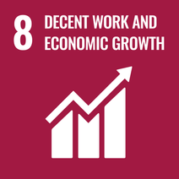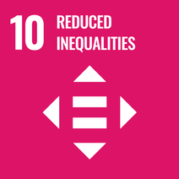
The number of people telecommuting in the U.S. increased 159% between 2005 and 2017. Over the last five years, remote work grew 44%, and over the last 10 years it grew 91%.
As more and more people join the remote work environment, its impact on communities, the environment, and the human race will continue to increase. In 2015, the United Nations (UN) released its Sustainable Development Goals (SDGs) to “achieve a better and more sustainable future for all.”
These 17 goals, created by the United Nations Development Program and adopted in 2015 by 193 countries, are “a universal call to action to end poverty, protect the planet, and ensure that all people enjoy peace and prosperity.”
Remote work can help meet the goals of the UN in a multitude of ways. In particular, eight of the SDGs can benefit from employers and employees embracing telecommuting and all of its benefits.

(Image credit: un.org)
Remote work supports eight of the UN’s Sustainable Development Goals (SDGs):
Goal 1. End poverty in all its forms everywhere.

Flexibility can be used to better accommodate people who have historically been left out of the traditional workforce. Whether it’s due to medical issues, mental health issues, a disability, a rural location without many job opportunities, or lack of access to transportation, many people are unable to find jobs that can financially meet their needs.
These barriers to employment can be eliminated or reduced with flexible work.
DeChe, A FlexJobs member, successfully found remote work via our services after spending five years trying to find work that paid a living wage. She suffered through homelessness, joblessness, and low-paying roles that could not support her. She was able to find a full-time, remote job that lets her work from home and pulled her out of poverty:
“Throughout the years my husband and I had been looking for a job. In fact it was so bad we actually went homeless and were living out of our car. … As soon as I signed up [for FlexJobs], redid my resume, and started on the applications, I was getting jobs left and right. All in the past two weeks, I’ve had five people email or call me for an interview and Amazon actually asked me to work for them … it was miraculous!”
Goal 3. Ensure healthy lives and promote well-being for all at all ages.

Within SDG No. 3 is a particular focus on reducing traffic accidents: “By 2020, halve the number of global deaths and injuries from road traffic accidents.” Globally, approximately 1.35 million people die each year as a result of road traffic crashes, and between 20 and 50 million more people suffer non-fatal injuries.
Remote work lessens or eliminates commutes, taking more cars and people off the roads each day. According to FlexJobs’ “State of Telecommuting in the U.S. Employee Workforce” report, the 3.9 million people who work from home save 7.8 billion miles traveled, avoid 530 million vehicle trips, and reduce traffic accidents costs by $498 million every year.
Additionally, remote working gives people more time and energy to focus on their diet, exercise, relationships, leisure, and passions—all contributors to better well-being and healthier lives.
According to Mental Health America, mental illness and substance abuse cost employers around $80 to $100 billion. Reducing the friction between work and life can dramatically reduce the stress and anxiety of workers, and help to prevent mental illness from starting or progressing.
Mikaela, a FlexJobs reader, provides a great example of remote work and healthy living merging together:
“Working environment is key to productivity and health for me. … The benefits of a healthy mind increases productivity, reduces stress, increases the quality of decision-making and problem-solving. There are less distractions than in an office setting and my mind can fully focus. … The quality of my life would increase dramatically with a healthy and happy mind and body, which is why I believe working remotely will highly increase the quality of my work and life.”
Goal 5. Achieve gender equality and empower all women and girls.

UN SDG No. 5 supports an equal playing field, and remote work and flexible schedules aid in achieving gender equality. With more of a focus on results, and not time-in-seat, working parents can often better handle work and life responsibilities. Parents who are able to flex their schedule and work when it is most convenient for them can often maintain a professional job and perform at a high level.
Our sister site, Remote.co, found that remote companies have more women CEOs and founders. Its data found that 28% of mostly or completely remote companies have either women CEOs, founders, or presidents and 19% have women CEOs, compared to the 5.2% of women CEOs at S&P 500 companies.
In an article written by FlexJobs CEO Sara Sutton about how remote workplaces benefit women, she said: “Remote work eliminates some of the obstacles that tend to throw women off the traditional leadership course: inflexible schedules, long hours away from home, and long commutes.”
With more of a focus on productivity, and less on likeability, politics, or hours spent at a desk, remote jobs can help women excel and close the gender equality gap.
FlexJobs readers who were asked what their “better” is in relation to life and work said:
“Better for me as a woman is being able to have a career I love while being able to help my children with homework. Better is… being able to work from anywhere earning a living while still having the flexibility to pick up a sick child from school.” —Vindra Gayapersad
“Better is being able to revitalize my career as I step back into the workplace full-time after being a part-time, stay-at-home mom for over 15 years. Being able to find a job with good benefits, a flexible schedule, and one that will allow me to do what I do best—help others. All this as I get ready to transition to being a single parent of three beautiful and extraordinary kids.” —Greer Gaston-Anderson
Goal 8. Promote sustained, inclusive, and sustainable economic growth; full and productive employment; and decent work for all.

Remote work can provide a solution to unemployment and under-employment. With telecommuting, an employee can work from their home office in a completely different city, state, or country from their employer. A talented graphic designer who can’t find professional, well-paying work in their rural location, can have access to graphic design jobs in other locations they would have never known about pre-technology.
As Sutton noted in a LinkedIn article, “… Nothing is more suited to help the workforce keep up with globalization more than telecommuting and flexible work. The market no longer has to be harnessed by time zones, geographic boundaries, or technological limitations.”
A job seeker looking for work will have increased options if they expand their search to include remote opportunities. This can cut unemployment rates and reduce time to find a job. With remote workers having been found to be more productive and loyal, longevity in their jobs and careers can increase.
The sentiment expressed by FlexJobs reader Michelle Shaver sums it up: “Better is utilizing my knowledge and skills in a remote position to help a company reach its goals, while allowing me the freedom of location and time to work when and where I choose instead of being tied to a desk 24/7.”
Goal 10. Reduce inequality within and among countries.

Economic development is a step in reducing inequality among our cities and states, a main driver of SDG No. 10. Flexible work can bring jobs to those who may not otherwise have access. Flexible work can provide better salaries, reduce expenses for workers, and therefore boost the local economy.
According to research from the World Economic Forum, the job market in rural areas is 4.26% smaller now than in 2008. In 2018, FlexJobs partnered with Teleworks USA to help close the urban vs. rural employment gap, specifically in Eastern Kentucky, which has an unemployment rate that’s nearly double that of urban areas.
Through the FlexJobs and Teleworks USA partnership, Kentucky residents were given access to remote jobs, training on working remotely, and assistance with preparing for virtual job interviews. As a result, 334 remote jobs were created for eastern Kentucky residents.
Subscribers who live in rural areas and found a flexible job from FlexJobs point out the necessity of remote work:
“I live in rural Arkansas. … Being able to make from-home earnings [that are] much higher than the average pay for my area is wonderful. In no time, I’ll be able to purchase a new car, but this job is going so well I plan to travel the world and continue to do this work…” —Mandi
“We had just moved to a rural area and in order to continue working in my field, I would need to commute an hour each way daily. … I thought that I had to choose between having a career and having time with my family because that had been my choice for many years. Now I realize that I can do just about anything remotely, and I love it!” —Jennifer
Goal 11. Make cities and human settlements inclusive, safe, resilient, and sustainable.

One aim of SDG No. 11 is to ensure people have access to safe and affordable housing. With increasing housing prices in many cities across the U.S., working remotely eases the need to live in city centers and allows options for housing locations that are further from the office and much more affordable.
Another target of this goal is to strengthen links between urban and rural areas for the benefit of both. With a remote job, professionals can live in smaller or rural areas, potentially helping to expose that area to different avenues of wealth and mentorship; especially valuable for young people who are developing personal and professional interests.
Creating safe and sustainable cities also involves air quality and road safety. Remote workers who no longer commute to work can help reduce traffic congestion and road wear and tear, reduce greenhouse gasses emitted, and reduce oil costs.
In Boston, Governor Charlie Baker is looking to ease traffic congestion by offering tax breaks for each employee that a company lets work remotely. Less traffic and more money back in the pockets of businesses can contribute to a safer and sustainable city.
FlexJobs reader Karen had this to say about the environmental savings of working remotely:
“Being able to work from home for me, not only saves immensely on my daily carbon emissions, it also allows for me to teach my children the importance of taking care of this planet that we live on. Whether it’s taking them on a walk to pick up trash or help our community plant trees for our local memorial park, those small teachable moments are more than I’d be usually be allowed. Every little thing counts.”
Goal 12. Ensure sustainable consumption and production patterns.

Part of goal 12 encourages companies to adopt sustainable practices. Employers can save about $11,000 per employee who works remotely part-time. Companies with remote workers need less office space, have lower utility bills, have less office equipment to purchase and maintain, and can spend less money expanding into new territories.
Translated to multiple workers—think of a company with hundreds or thousands of people who don’t need to be in the office every day—and you’re looking at big bucks. The businesses that pilot and then roll out flexibility, and see the environmental and bottom-line benefits, serve as important case studies and encouragement for others to adopt this sustainable practice.
Mariam Rowhani shared about how working remotely helps both her company and herself live more sustainably:
“The earth is suffering because of humanity’s carbon footprint. By being a remote worker, I drive less and waste less gasoline. It is far healthier for me and much less stressful. Also it helps employers from having to provide electricity and cuts down on office waste when managing multiple employees. And it is about working smarter, which improves productivity and focus.”
Goal 13. Take urgent action to combat climate change and its impacts.

The environmental impact of virtual work can’t be understated. FlexJobs’ telecommuting report estimated that 3 million tons of greenhouse gases are avoided each year and oil savings reach $980 million due to the 3.9 million people working remotely at least half time. That’s the equivalent of taking 617,000 cars off the road. To put it in perspective, it would take the planting 91 million trees to offset the same level of emissions, according to 2017 data from Global Workplace Analytics.
Global Workplace Analytics also notes that office equipment energy consumption rate is twice that of home office equipment energy consumption, and 70% of employees report they would see their companies in a more favorable light if they helped them reduce their carbon emissions.
Laura, a FlexJobs reader, shared this:
“I have now worked exclusively at home for almost 24 years. By the estimate above, I’ve avoided emitting 86,400,000 tons of commuting-related greenhouse gasses annually (that’s the equivalent of planting over 2 billion trees!). The wear and tear on my vehicle is also reduced exponentially. My car stays in the garage almost every weekday, unless I have any work-related errands to run, reducing wear and tear on my car, oil changes, and gas usage. When I started working at home, it was a convenience, but looking at these numbers, I now see it as my own contribution to saving the planet.”
There is also the added benefit of remote workers being able to continue working through major weather events, such as floods, snow storms, and heat waves. This adds resilience to the economy and decreases risks to individuals even if disasters continue to increase due to climate change.
Work Flexibility, the Environment, and the UN’s SDGs
Remote work supports roughly 50 percent of the UN’s SDGs. The benefits to companies, employees, and the environment are clear. Learn more how you and your company can begin contributing to environmental sustainability through flexible work arrangements.
LEARN MORE ABOUT THE UN’S SUSTAINABLE DEVELOPMENT GOALS >>>
Photo Credit: bigstockphoto.com
Don't forget to share this article with friends!

FlexJobs Is SO Much More Than Just a Job Board
In addition to helpful articles like this one, members get unlimited access to:
- Highest Quality Remote & Flexible Jobs
- 200+ Expert Skills Tests
- Soft Skills Courses
- Virtual Job Fairs
- Weekly Career Coach Q&As
- And so much more…

















Elizabeth from Dallas, TX
Just purchased the 3 - Month plan
Schevaun from
Just purchased the Monthly plan
Linda from Snohomish, WA
Just purchased the Monthly plan
Rachael from Knoxville, IA
Just purchased the Monthly plan
Cari from Beaumont, TX
Just purchased the Yearly plan
Marquise from Stone Mountain, GA
Just purchased the Monthly plan
Ticey from Andover, KS
Just purchased the 3 - Month plan
Daniela from Bogota, Bogotá
Just purchased the Monthly plan
Vickie from Oklahoma City, OK
Just purchased the Monthly plan
Jake from Mission Viejo, CA
Just purchased the Monthly plan